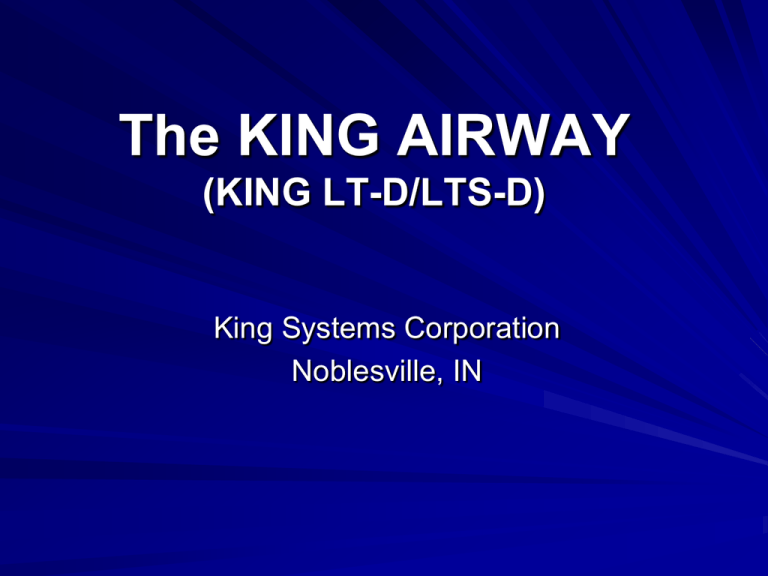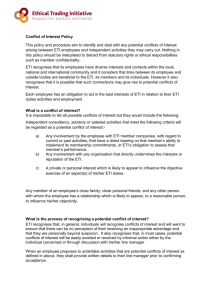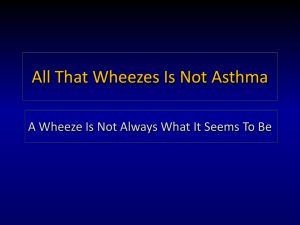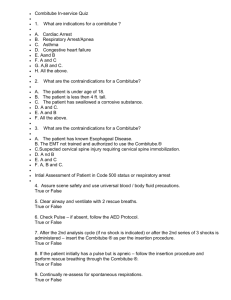The LARYNGEAL TUBE (The KING LT®)
advertisement

The KING AIRWAY (KING LT-D/LTS-D) King Systems Corporation Noblesville, IN Presentation Outline Background Product Description Placement Instructions Clinical Experience Manikin practice (if necessary) Background Increasing interest in alternative airways – Supraglottic, supralaryngeal, extraglottic, oropharyngeal – Back-up for failed intubation – Poor success rates for pre-hospital tracheal intubation – Alternative to BVM – Need is to ventilate, not necessarily intubate Need for a simple, intuitive ventilatory device Background – KING LT KING LT-D™ – single lumen for ventilation KING LTS-D™ – Double lumen (second lumen for gastric access The “King Tube” or “King Airway” Product Description Easy insertion based on esophageal intubation High volume, low pressure cuffs Sizing – based on height – Color-coded – Design and placement instructions make size selection less critical Product Description King Tube: Designed for Esophageal Tip Placement King LT-D™ vs. Combitube™ Placement Instructions Insertion Cuff Inflation Alignment/Positioning Placement Instructions – Step 1 Placement Instructions – Step 2 Placement Instructions – Step 3 Placement Instructions – Step 4 Placement Instructions – Step 5 Placement Instructions – Step 6 Gastric Tube Insertion Insertion Challenges Inability to advance tip around corner in posterior pharynx – Use lateral approach – Chin lift/jaw thrust – Use tongue depressor – Use laryngoscope Insertion with Chin Lift Laryngoscopic insertion Cuff Inflation Best technique: inflate to 60cm H2O pressure Impractical in emergency situation Range of volumes determined for each size Bottom line: use 60ml syringe for adult sizes (35ml syringe for sizes 2 and 2.5); adjust as needed Prevention of over-pressure most important when King Airway is left in place for more than an hour or two. Cuff Inflation Size KING LTS-D KING LT-D 2 25-35ml 2.5 30-40ml 3 40-55ml 45-60ml 4 50-70ml 60-80ml 5 60-80ml 70-90ml Alignment/Positioning How to align ventilatory openings with laryngeal inlet – Place deeply into esophagus (connector to the teeth), inflate cuffs, then withdraw while bagging until ventilation is easy and freeflowing – Cannot advance with cuffs inflated – Detects tracheal placement – Ability to ventilate confirms alignment – Deeper placement more secure Alignment/Positioning Original design included markings to be aligned with the teeth If ventilation not possible, it was not known whether too deep or too shallow Initial deep insertion accounts for variable anatomy and provides for size accommodation Depth (cm) markings provided for reference purposes only Alignment/Positioning Tracheal Placement No documented tracheal placement of KING LT-D or LTS-D “It is important to note that no inadvertant tracheal intubation, which would lead to complete obstruction of the airway, occurred. Even using a laryngoscope, we were not able to place the laryngeal tube in the trachea due to the form and length of the tube.” Genzwuerker H et al. The Laryngeal Tube: A New Adjunct for Airway Management. Prehosp Emerg Care 2000; 4(2): 168-72. Other Misplacement Pyriform sinus :“bouncing sign". Reposition. Matioc A. Can J Anesth.2004; 51(3): 278-9. CONFIRM LT POSITION: Auscultation. Chest movement. Verification of CO2. Pediatric FOS (when contemplating exchanging to an ETT). Exchange of King Airway Exchange of King Airway Tube exchange catheter is directed anteriorly out ventilatory opening However, blind passage is not reliable Visual confirmation of catheter placement in trachea is needed for best results Due to good ventilatory function, urgent exchange usually not necessary Exchange of King Airway Clinical Experience Manikin studies EMS studies Case reports Manikin Studies (EMS) Kurola J et al. Resuscitation 2004; 61:149153. – 60 EMT’s LT vs. ETI vs. BVM – Initiation of ventilation faster with LT than ETI – Compared to BVM, better MV with LT – LT provided equal MV to ETI Manikin Studies (EMS) Russi C et al. American Journal of Emergency Medicine; 2007, 25:263–267. – EM Residents, 4th Yr Med Students, paramedic students – ETI vs. LT with and without cervical collar – LT faster (27s vs. 76s) with C-collar – LT success rate 94% vs. 69% with ETI – No tracheal placements occurred with LT Manikin Studies (EMS) Russi et al. Prehosp Emerg Care 2008; 12(1):35-41 – 69 pre-hospital providers, EMT-P and EMT-B – LT vs. Combitube, ETI – EMT-P Mean placement times: 27.0, 53.7, 91.3 sec, respectively for LT, ETC, ETI – Success rates: 100%, 82.2%, 68.9% respectively – 92.3% rated LT easier to insert than ETi – 94.2% rated Lt easier to insert than ETC Russi et al (cont.) “Of practical consideration, higher user confidence with placing the LT combined with fewer steps in its placement sequence should aid EMS personnel in successfully establishing and maintaining an airway with the KING LT in the stressful, distracting field conditions in which they often find themselves.” Manikin Studies (EMS) Norris et al. Intubating Under the Gun; A Comparison of Different Secured Airways in a Simulated Combat Scenario. – King Airway vs. Combitube, ETI – 20 paramedics – Paramedics were able to secure the airway more quickly and with the least exposure using the KING LT-D EMS Studies Kette F et al. Resuscitation 2005; 66:21-5. – LT used in out-of-hospital emergencies by minimally trained nurses – 30 pts, all in cardiac arrest; 7 from trauma – 83% success rate – No episodes of regurgitation or vomiting, no blood staining on the LT – Based on ease of insertion, adequacy of ventilation and protection from aspiration, 86.7% of nurses expressed positive impression of the LT EMS Studies Guyette F et al. Prehospital Emergency Care; 2007, 11:1-4. – Large regional air medical service – 9 month period with 575 ETI’s – Alternate airway used after 3 failed ETI attempts or in situations of anticipated ETI difficulty – 27 alternate airways used: 26 LT-D, 1 ETC – All 26 KING LT-D’s were successfully placed – No immediate complications observed – Follow-up data available for 15 pts; 4 emergent trachs – Range of airway difficulties encountered: cervical immobilization, oropharyngeal trauma, obesity and anterior anatomy Guyette et al (cont.) Several cases where flight crew deferred ETI, electing to place the King Airway. In all cases, it functioned satisfactorily. Crews chose King Airway over Combitube 26/27 times despite considerably more training and experience with the Combitube. Crews have noted during training that they are able to place the King Airway with greater speed and reliability than the Combitube. Guyette et al (cont.) The hospital course included extensive airway management by anesthesia and surgical staff. In many cases, the King Airway was left in place and used to adequately ventilate while definitive diagnostic and therapeutic procedures were performed. EMS Studies Russi et al. Int J Emerg Med 2008; 1:135-8. – 12 month pilot study in rural EMS setting – King Airway used as primary airway or as back-up adjunct – 13 patients with cardiopulmonary or traumatic arrest – 6 cases following ETI failure – 3 cases following ETC failure – King Airway placed without difficulty in 12/13 pts Case Reports Pharyngeal and laryngeal tumors Lingual tonsillar hyperplasia Morbid obesity Unstable neck “Failed LMA insertion” (enlarged tonsils/ “narrow pharynx”) Use in Iraq, Afganistan Conclusion: King LT(S)-D™ Simple, intuitive device Insertion: easy and quick (“esophageal intubation”) Effective in elective, “difficult”, “critical” airways and during CPR. Efficient oxygenation/ventilation with high airway pressure LTS-D: efficient gastric access Low incidence of minor complications No reports: pyriform sinus trauma, esophageal perforation, tracheal intubation, aspiration. Conclusion: King Airways Useful as a back-up for failed ETI Alternative to BVM – better ventilation, less gastric insufflation Airway of choice in some instances – Insufficient practice/training with ETI – Cardiac arrest Airway of choice for US Military Medics Questions?







